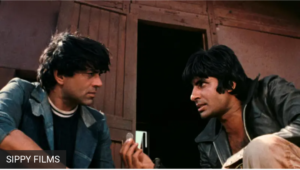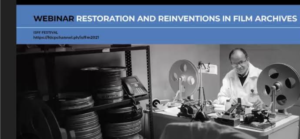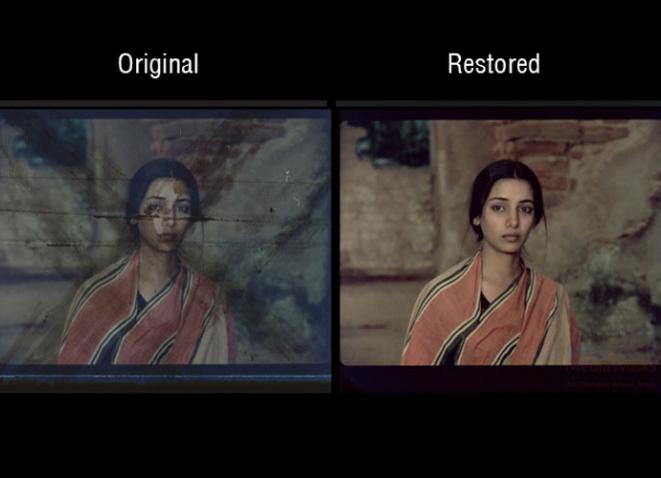
Film Restoration : Sholay
Jul 06 2025
Film restoration is a major step into bring the old films back to latest viewing form as it was filmed and viewed during that particular era in its original form.
Latest film is Sholay great Indian Cinema that redefined mainstream commercial film making.
Sholay was directed by Ramesh Sippy who was few years back honored by Govt of India as Legends of Cinema at Goa Film Festival along with PC Sreeram

🎞️ What is a Film Negative?
🧾 Definition:
A film negative is the original image captured directly on film stock in a motion picture camera. It is called a negative after it is processed , because the colors and brightness levels are inverted—light areas appear dark and vice versa.
🎥 Function:
- It’s the source material for all other versions of the film (interpositives, internegatives, prints).
- Holds the highest image detail and dynamic range.
- Essential for high-quality restoration, grading, and reprinting.
📏 Forms & Sizes:
- 35mm – Industry standard for decades. Offers cinematic depth and quality.
- 16mm – Used for documentaries, low-budget, or educational films.
- 70mm – Larger format used for epic visuals (e.g., Lawrence of Arabia, Sholay in blow-up form).
🔍 Resolution (approximate digital equivalent):
| Film Stock | Native Resolution (Digital Equivalent) |
|---|---|
| 16mm | 1.5K – 2.5K |
| 35mm | 3K – 6K |
| 70mm | 8K – 18K |
📽️ What is a Release Print?
🧾 Definition:
A release print is the final positive copy of a film that is distributed to movie theaters for public projection. It is made from a duplicate negative or internegative, several generations removed from the original.
🎥 Function:
- Used for screening in cinemas.
- Printed in positive color format—ready to view as-is.
- Lower in image quality due to generational loss.
📏 Forms & Sizes:
- 35mm – Most common for commercial release.
- 16mm – For educational or regional screenings.
- 70mm – For high-end screenings with large-format impact.
🔍 Resolution (approximate digital equivalent):
| Print Type | Effective Resolution |
|---|---|
| 35mm Print | 1.5K – 2.5K |
| 70mm Print | 4K – 6K (sometimes more) |
🧠 Because prints are multiple generations removed from the negative, they suffer from contrast loss, softness, and noise. They’re not ideal for digital restoration but may be used if no better source survives.
🔄 Negative vs. Release Print: A Quick Comparison
| Feature | Film Negative (OCN) | Release Print |
|---|---|---|
| Generation | 1st (original image) | 3rd or 4th (duplicate copy) |
| Image Quality | Highest | Lower |
| Color | Inverted (needs processing) | Final viewable colors |
| Use | Archival, restoration | Theatrical projection |
| Resolution | 3K–6K (35mm), 8K+ (70mm) | 1.5K–2.5K (35mm), ~4K (70mm) |
| Restoration Suitability | Best source | Acceptable if nothing else |
🧊 Why This Matters for Restoration
- Best Practice: Always use the OCN if available—it’s the cleanest and richest source.
- Fallbacks: When the OCN is lost or damaged (as with Sholay), use interpositives, reversal intermediates, or prints—but be ready for more digital cleanup and upscaling.
- Goal: Restore the film as close as possible to what the audience would have experienced when it was first made—preserving texture, tone, and emotion.
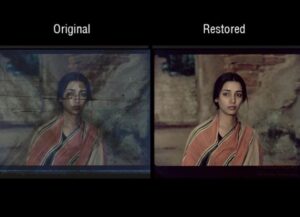
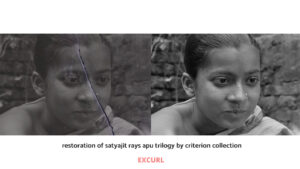
🎞️ What Is Film Restoration?
Film restoration is the process of reviving old, damaged, or deteriorated films and preparing them for modern viewing—without losing the essence of the original. This isn’t just about cleaning up scratches or improving resolution. It’s about honoring a film’s legacy and ensuring that future generations can experience it as it was meant to be seen—or better.
🧾 Why Is It Necessary?
- Time is cruel to celluloid. Heat, humidity, poor storage, and chemical reactions (like vinegar syndrome) can destroy film reels.
- Some classics are lost forever. Others survive in partial or poor-quality forms.
- Film restoration saves not just movies, but memories, culture, language, fashion, politics, and artistic vision.
🎬 Understanding the Materials: What Are We Restoring?
✅ Original Camera Negative (OCN)
- The first-generation film stock exposed in the camera.
- Contains maximum detail and dynamic range.
- Extremely fragile but ideal for restoration—when available.
❌ Release Print
- Several steps removed from the original.
- Meant for projection, not preservation.
- Lower in resolution, contrast, and color accuracy.
🔍 Other Elements:
- Interpositives / Internegatives: Intermediate stages between OCN and release prints. Often used when the OCN is missing.
- Color Reversal Intermediates (CRI): Positive film elements used for duplication, often with better contrast.
- Sound Negatives / Magnetic Tapes: Original audio sources used for re-syncing and remastering.
🛠️ The Restoration Process — Step by Step
1. Sourcing Surviving Elements
Restorers track down the best available materials worldwide—often hidden in warehouses, archives, or private vaults.
2. Cleaning and Repair
Films are gently cleaned, chemically treated, and physically repaired (tears, warps, etc.). Ultrasonic cleaning and sprocketless handling are common.

3. High-Resolution Scanning
The clean reels are scanned at 4K or 8K resolution, depending on the film stock and condition. This provides a digital base for restoration.
4. Digital Image Restoration
Using AI tools and human precision:
- Scratches, flickers, and dust are removed.
- Colors are balanced and restored to match original tones.
- Grain is managed to retain the filmic feel without noise.
- Jitter, shake, and warps are corrected.
5. Sound Restoration
Audio is digitized and cleaned of hisses, pops, and distortions. In many cases, the sound is remixed for surround sound or Atmos.
6. Final Output and Archiving
The restored film is rendered in high resolution, matched to its original aspect ratio. It’s then preserved as digital masters and, if possible, new film negatives, stored under controlled conditions for long-term protection.
🌟 Case Study: Sholay (1975) – 50th Anniversary 4K Restoration
🔹 The Challenge
- The original 35mm camera negative was unusable, heavily damaged by vinegar syndrome (a condition that causes shrinking, stickiness, and chemical breakdown).
- No 70mm prints survived—despite its fame as India’s grand 70mm western.
🔹 The Solution
Restorers used:
- Two color reversal intermediates and an interpositive found in a UK warehouse.
- A 1978 interpositive stored by Sippy Films and preserved by FHF.
- The original sound negative and magnetic track for audio.
🔹 The Restoration
- Digitally restored to 4K resolution while maintaining the original 2.2:1 aspect ratio.
- AI tools and manual cleanup removed extensive damage and restored color vibrancy.
- The original ending and two deleted scenes were reinstated, offering audiences the uncut Director’s Cut for the first time in decades.
🔹 The Premiere
The restored Sholay was unveiled at the prestigious Il Cinema Ritrovato Festival in Bologna on June 27, 2025, projected on the massive open-air screen of Piazza Maggiore—bringing India’s most epic film back to life in epic fashion.
🎥 Other Iconic Indian Restorations
🔸 Kummatty (1979, Dir. G. Aravindan)
- Restored in 4K by Martin Scorsese’s World Cinema Project, Film Heritage Foundation, and Cineteca di Bologna.
- A dreamlike Malayalam children’s film now preserved for global audiences.
🔸 Ishanou (1990, Dir. Aribam Syam Sharma)
- A Manipuri-language classic chosen for Cannes Classics 2023 after its 4K restoration.
- A proud milestone for regional Indian cinema on the global stage.
🧠 What Makes a Restoration “Authentic”?
- It’s not just about clarity or color.
- It’s about respecting the filmmaker’s original vision—aspect ratio, frame rate, grain, contrast, soundtrack—all matter.
- An authentic restoration doesn’t “modernize” a film. It revives it as if time had never touched it.
📚 India’s Restoration Movement: The Bigger Picture
- Film Heritage Foundation (FHF) has emerged as a key player, restoring India’s classics with international partnerships.
- From Sholay to Kummatty, efforts are underway to preserve India’s cinematic identity, region by region.
- AI-powered restoration, 4K/8K scanning, and archival standards now place India on par with global film conservation movements.
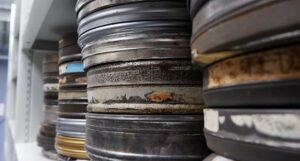
🎯 Conclusion: More Than Movies
Restoring films is about restoring identity—cultural, artistic, and emotional. It bridges the past and future, allowing today’s audiences to experience classics not as faded memories but as timeless works of cinema, recharged for new life.
Whether it’s the grandeur of Sholay or the quiet magic of Kummatty, film restoration ensures these stories remain alive, relevant, and radiant.
Article by
CJ Rajkumar
Author/ Cinematographer

